A Shrine to the CPC still Pulls in the Crowds
It’s that time of the year again… or rather that time every five years when China’s political elite meet to set their goals for the next five year plan. Every TV and radio station, not to mention every newspaper, magazine and social media site becomes obsessed with covering the National Party Congress and the majority plump to visit – yet again – the site where the very first national congress took place in Shanghai.
The 1st National Congress of the Communist Party of China was held between July 23 and August 2, 1921. This is where the Communist Party of China was officially formed – in a shikumen building (an architectural style with carvings on the stone gate, popular in Shanghai during the 1920s) in the French Concession area near present-day Xintiandi, at 76 Xingye Road (formerly 108 Rue Wantze). The site was converted into a museum in 1961.
It’s obviously regarded as a national shrine – somewhere the Party faithful come to tick it off their list of places to see before they die. The queues stretch down the road…
Lest anyone get the wrong idea, there is a stricture in the admission rules posted outside the building that “those who are improperly dressed, drunken or insane are not allowed”; but I see no one, on this occasion at any rate, who is refused entry for being insane.
Unless you have a Chinese national ID card you have to get your admission ticket by placing your thumb on a fingerprint scanner, after which a ticket pops out of the machine that you immediately hand to a gatekeeper standing beside you in order to be let inside. Naturally everything in such an important building as this is scanned for security, though you are reminded not to leave anything behind once you leave the security area.
The two-storey Shikumen building was only completed in 1920 as the residence of two of the original Communist Party members. In the entrance hall is a large bronze relief of the good and the great who attended that first meeting in 1921. There were 13 of them in all: Mao Zedong, He Shuheng, Dong Biwu, Chen Tanglu, Wang Jinmei, Deng Enming, Li Da, Li Hanjun, Zhang Guotao, Liu Renjing, Chen Gongbo, Zhou Fohai and Bao Huiseng. In addition, two representatives sent by the Comintern (the Communist International) attended the meeting as non-voting delegates.
Naturally everyone wants their picture taken in front of the relief, such as this group who even pull out their communist flag with which to pose. But horror of horrors… they have let it touch the floor and minders quickly bark out an order to them to lift it off the floor so as not to disrespect the Party. An embarrassed group repose for a second selfie.
The minders, it has to be said, obviously have a difficult task on their hands. Not only do they have to keep out the insane and ensure that communist party flags are not allowed to be draped on the floor, but if this notice is to be believed, then the way people behave here needs also to be monitored. Heaven forbid that anyone should display bad manners in this cradle of Chinese communism.
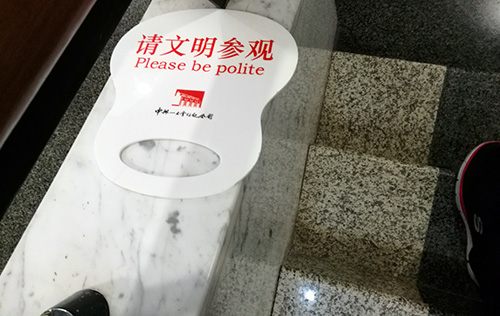
In the permanent exhibition upstairs, in which we all start our tour, there is a fully fledged history lesson awaiting us, spelling out in detail how the naughty Western colonialists had carved up Asia between them.

The Boxer Rebellion, or Yihetuan Movement, for instance, was a violent anti-foreign uprising that took place in China between 1899 and 1901, toward the end of the Qing dynasty. It was initiated by the Militia United in Righteousness (Yihetuan), known in English as the "Boxers", for many of their members had been practitioners of the martial arts, such as boxing. They were motivated by proto-nationalist sentiments and opposition to Western colonialism and associated Christian missionary activity.
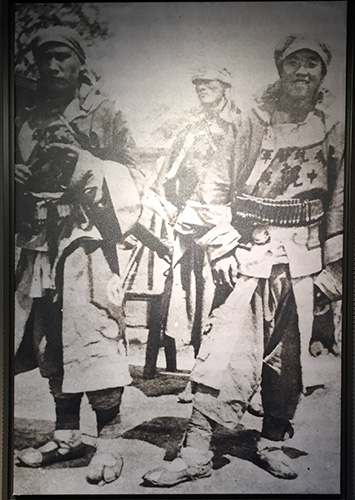
The Boxer Protocol was signed on September 7, 1901, between the Qing Empire and the Eight-Nation Alliance that had provided military forces after China's defeat in the intervention to put down the Boxer Rebellion at the hands of the Eight-Power Expeditionary Force.
450 million taels of fine silver were to be paid as indemnity over a course of 39 years to the eight nations involved. The Chinese handed this over until the debt was paid off on December 31, 1940. After 39 years, the amount came to around 37,000 tonnes of gold.
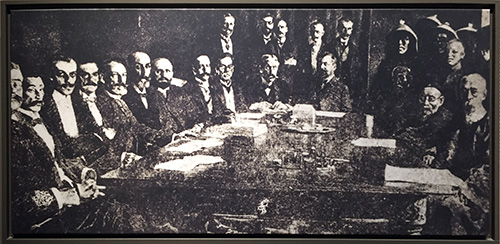
On November 7th 1917 the October Revolution broke out in China’s northern neighbour Russia and the first socialist country in the world was founded. Here’s a copy of an oil painting on display, called Lenin Proclaims Soviet Power.
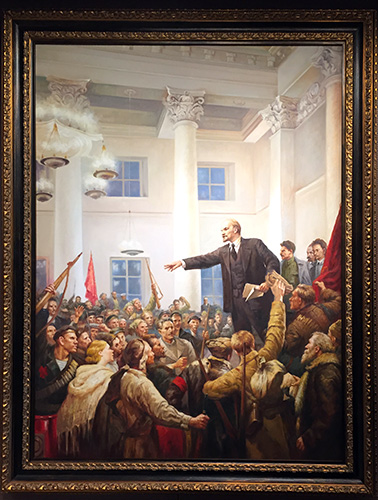
Following the October Revolution, a number of intellectuals, including Chen Duxiu and Li Dazhao, latched on to Marxism and under the attention and push of the Communist International (Comintern), the CPC's early organisations were established in Shanghai, Beijing and various other places.
Here's a picture of Li Dazhao (1889-1927) in a gallery depicting the principle founders of the CPC…
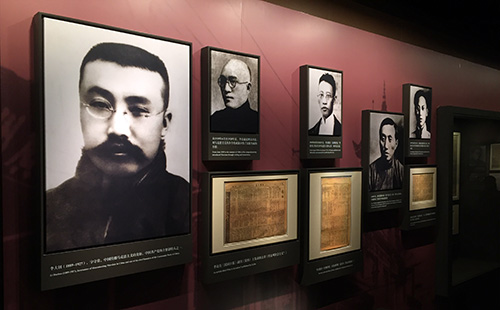
…and there’s even Li Dazhao’s typewriter on display. Gosh!
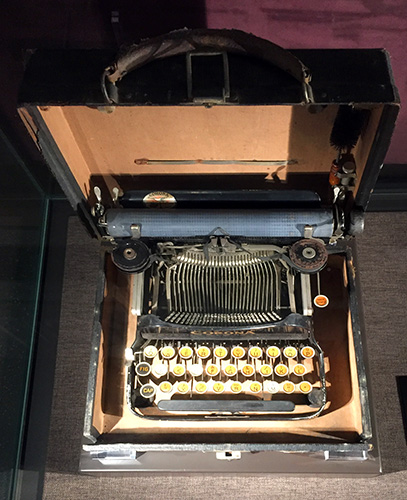
In early June 1921, a Dutchman called Henk Sneevliet, who was also known as Ma Lin, and was a representative of the Comintern, arrived in Shanghai, and urged various communist cells in the country to get together for a national-level meeting.
I wonder how many people know that it was a Dutchman who was in part responsible for the eventual establishment of modern day China.
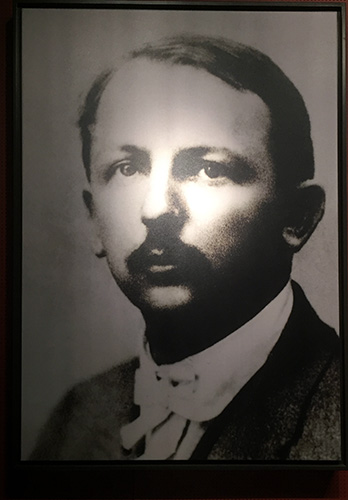
Russian Comintern representative Nikolski also attended the meeting. At the time, there were only 57 members of the Communist Party of China in the entire country.
Among the 13 delegates to that first congress was a man from Hunan whose mug shot was to end up on the country’s bank notes. Wow, I’ll bet his mum would have been proud as punch if she had been told that!
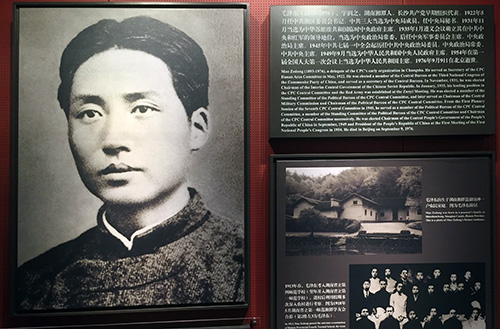
In one of the upstairs rooms is a waxwork tableau of the delegates huddled round a table for the convening of the first conference. According to travelchinaguide.com , “the other twelve members listen and smile as Mao Zedong, founder of the PRC, makes his speech. Lifelike, the wax figures seem to make time stand still, bringing people back to that exciting moment.”
I try to contain my excitement.
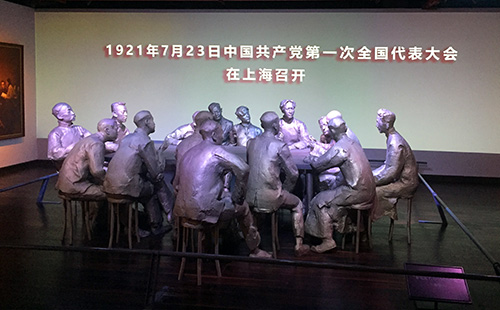
When you finally get downstairs to see the actual 18-square-metre room and table used, it’s hard to imagine how they all managed to crowd into that small area. And the stools they used upstairs look nothing like the chairs on display downstairs. But then, why let the facts get in the way of a good bit of artwork…
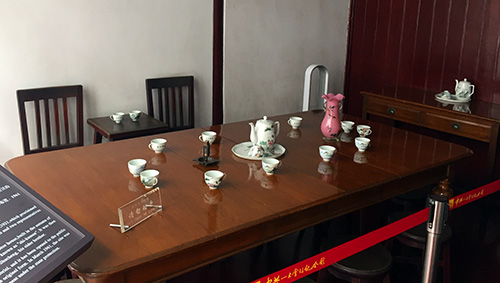
Above the actual table, I rather like this pull-down lampshade.
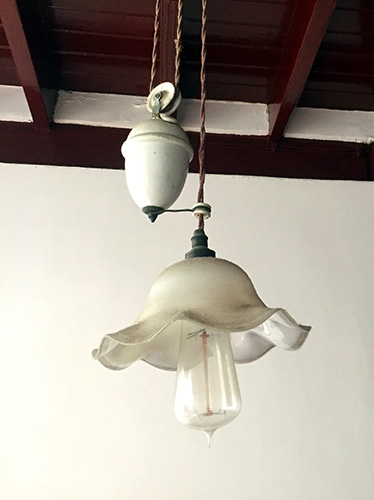
Of those 13 representatives in attendance at the Congress, it’s salutary to note that only Mao Zedong and Dong Biwu survived 'in good standing' by the end of the Cultural Revolution. Others were persecuted to death, left the Communist Party, were expelled, or defected to the Wang Jingwei government.
That meeting of the first congress came to a hurried conclusion owing to harassment from the French Concession police on July 30. The meeting had to be curtailed early and then resumed on board a boat in Jiaxing’s South Lake, where of course, yet another museum was finally opened in 2011.
To get to the 1st Congress museum, take Subway Line 1 to South Huangpi Road station. Leave from Exit 2 and walk along South Huangpi Road till you get to 76 Xingye Road on your right hand side.
